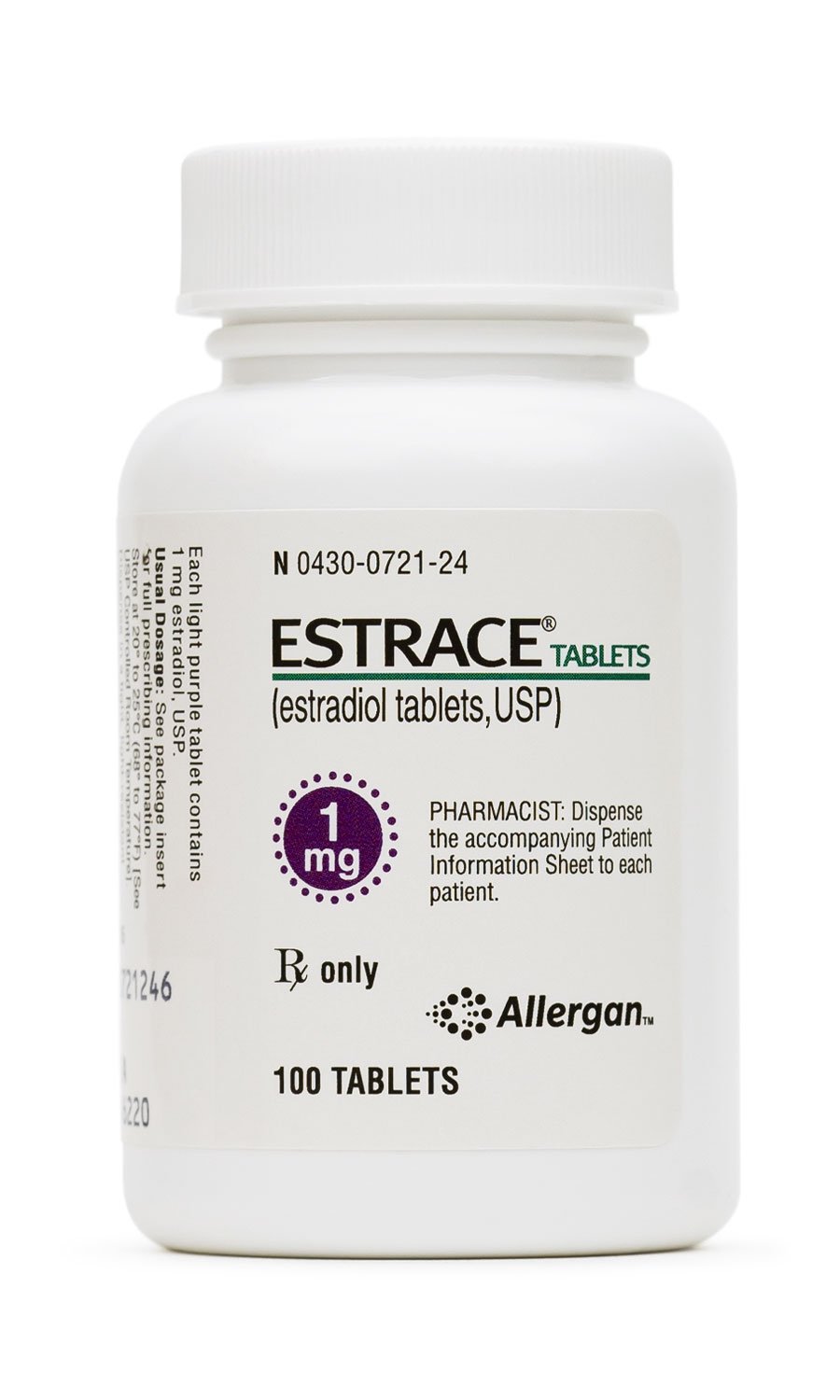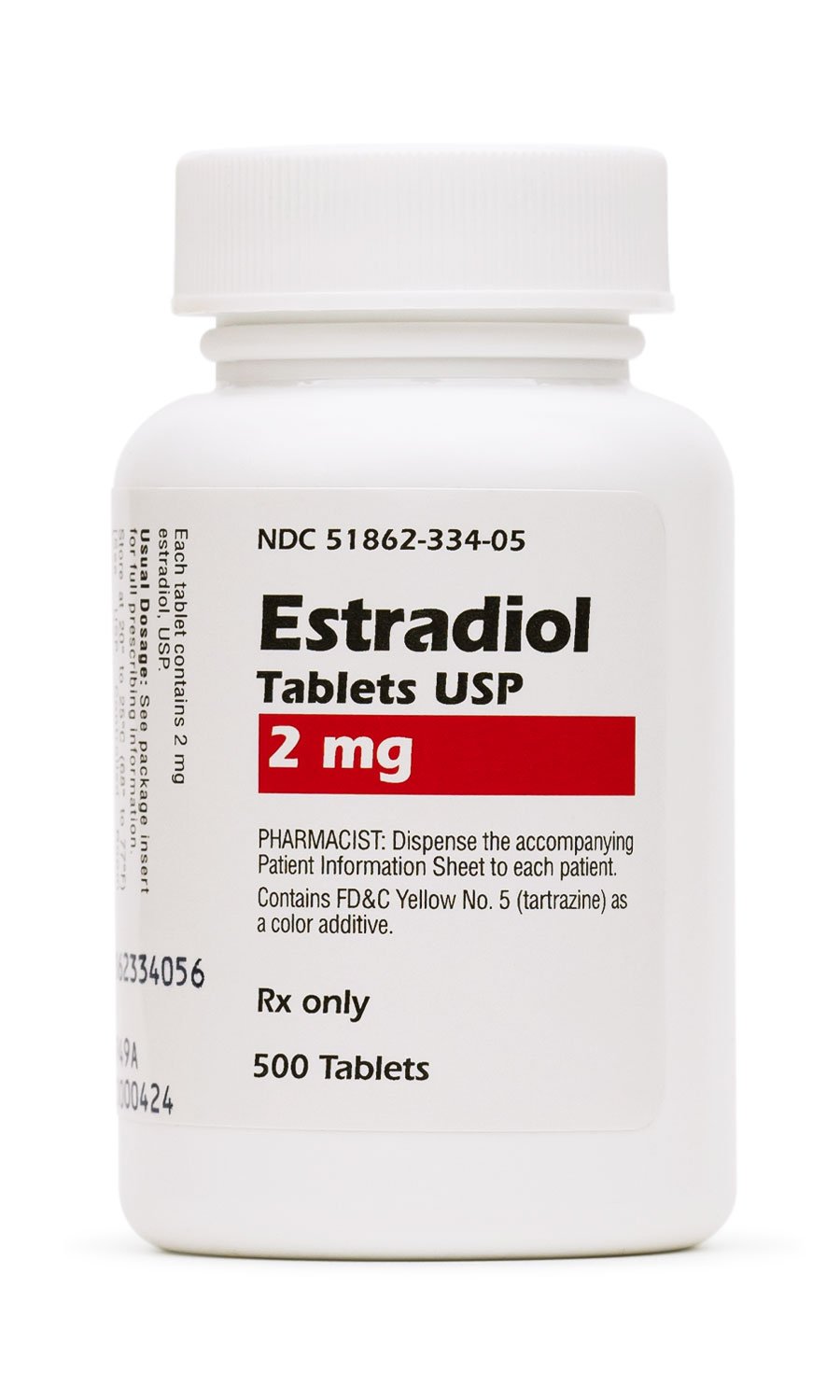Do not use estradiol products in patients with a known hypersensitivity to any of the specific product ingredients; estradiol is contraindicated in patients with known anaphylactic reactions or history of angioedema to the drug. Cases of both anaphylactic reactions and angioedema have been reported in patients taking estrogens, including estradiol. Events have developed in minutes and have required emergency medical treatment. Exogenous estrogens may also induce or exacerbate symptoms of angioedema, particularly in women with hereditary angioedema, which can be hormonally sensitive.
Estradiol products are contraindicated in patients with a known or suspected estrogen-dependent neoplasm, including breast cancer. The use of estrogen-alone and estrogen plus progestin has been reported to result in an increase in abnormal mammograms, requiring further evaluation. All women taking estrogen with or without a progestin should receive an annual clinical breast examination, perform monthly self-examinations, and have regular mammograms as recommended by their health care professional based on patient age, risk factors, and prior mammogram results. Since the 1970’s, numerous epidemiological studies have examined the association of estrogens or combined hormone replacement therapy (HRT) and breast cancer (new primary malignancy). The data available are derived from studies of estrogen-alone or estrogen plus progestin hormonal replacement therapy (HRT). The most important randomized clinical trial providing information about breast cancer in estrogen-alone users is the Womens Health Initiative (WHI) substudy of estrogen-alone therapy. In the WHI estrogen-alone substudy, after an average follow-up of 7.1 years, daily estrogen monotherapy was not associated with an increased risk of invasive breast cancer [relative risk (RR) 0.80]. The most important randomized clinical trial providing information about breast cancer in patients taking combined estrogen-progestin HRT regimens is the WHI substudy of estrogen plus a progestin. After a mean follow-up of 5.6 years, the WHI estrogen plus progestin substudy reported an increased risk of invasive breast cancer in women who took daily estrogen plus progestin vs. placebo. In this substudy, prior use of estrogen-alone or estrogen plus progestin therapy was reported by 26 percent of the women. The relative risk of invasive breast cancer was 1.24, and the absolute risk was 41 versus 33 cases per 10,000 women-years, for estrogen-progestin compared with placebo. Among women who reported prior use of hormone therapy, the relative risk of invasive breast cancer was 1.86, and the absolute risk was 46 vs. 25 cases per 10,000 women-years for estrogen-progestin compared with placebo. Among women who reported no prior use of hormone therapy, the relative risk of invasive breast cancer was 1.09, and the absolute risk was 40 vs. 36 cases per 10,000 women-years for estrogen-progestin compared with placebo. In the same WHI substudy, invasive breast cancers were larger, were more likely to be node positive, and were diagnosed at a more advanced stage in the combined HRT group compared with the placebo group. Metastatic disease was rare, with no apparent difference between the 2 groups. Other prognostic factors, such as histologic subtype, grade and hormone receptor status did not differ between the 2 groups. Consistent with the WHI clinical trial, observational studies have also reported an increased risk of breast cancer for estrogen plus progestin therapy, and a smaller increased risk for estrogen-alone therapy, after several years of use. The risk increased with duration of use, and appeared to return to baseline over about 5 years after stopping treatment (only the observational studies have substantial data on risk after stopping). Observational studies also suggest that the risk of breast cancer was greater, and became apparent earlier, with combined HRT as compared to estrogen-alone therapy. However, these studies have not found significant variation in the risk of breast cancer among different estrogen plus progestin combinations, doses, or routes of administration. While estrogen therapy may be used rarely for the palliative treatment of advanced breast cancer in men and women, estrogen administration may lead to severe hypercalcemia in patients with breast cancer and bone metastases. If hypercalcemia occurs, use of the drug should be stopped and appropriate measures taken to reduce the serum calcium level.
Estradiol products are contraindicated in women with estrogen-dependent neoplasms, including ovarian cancer. What is known about the risk of ovarian cancer due to estrogen-containing hormonal replacement therapy (HRT) regimens is derived from data available for estrogen-alone and estrogen plus progestin products. The Women’s Health Initiative (WHI) estrogen plus progestin substudy reported a statistically non-significant increased risk of ovarian cancer. After an average follow-up of 5.6 years, the relative risk for ovarian cancer for estrogen plus progestin versus placebo was 1.58 (95% CI 0.77 to 3.24). The absolute risk for estrogen plus progestin versus placebo was 4 versus 3 cases per 10,000 women-years. A meta-analysis of 17 prospective and 35 retrospective epidemiology studies found that women who used hormonal therapy for menopausal symptoms had an increased risk for ovarian cancer. The primary analysis, using case-control comparisons, included 12,110 cancer cases from the 17 prospective studies. The relative risk associated with current use of hormonal therapy was 1.41 (95% confidence interval [CI] 1.32 to 1.5); there was no difference in the risk estimates by duration of the exposure (less than 5 years [median of 3 years] vs. greater than 5 years [median of 10 years] of use before the cancer diagnosis). The relative risk associated with combined current and recent use (discontinued use within 5 years before cancer diagnosis) was 1.37 (95% CI 1.27 to 1.48), and the elevated risk was significant for both estrogen-alone and estrogen plus progestin products. The exact duration of hormone therapy use associated with an increased risk of ovarian cancer, however, is unknown.
Estrogen therapy is contraindicated in patients with known estrogen-dependent malignancies. There is an association of unopposed estrogen therapy and endometrial cancer in women with an intact uterus. Adding a progestin to estrogen therapy has been shown to reduce the risk of endometrial hyperplasia, which may be a precursor to endometrial cancer. Clinical surveillance of all women using estrogen-alone or estrogen plus progestin therapy is important. Adequate diagnostic measures, including directed or random endometrial sampling when indicated, should be undertaken to rule out malignancy in postmenopausal women with undiagnosed persistent or recurring abnormal vaginal bleeding. The reported endometrial cancer risk among unopposed estrogen users is about 2- to 12-times greater than in non-users, and appears dependent on duration of treatment and on estrogen dose. Most studies show no significant increased risk associated with use of estrogens for less than 1 year. The greatest risk appears associated with prolonged use, with increased risks of 15-to 24-fold for 5 to 10 years or more, and this risk has been shown to persist for at least 8 to 15 years after estrogen therapy is discontinued. There is no evidence that the use of natural estrogens results in a different endometrial risk profile than synthetic estrogens of equivalent estrogen dose. With concurrent progestin use (cyclically or continuously), the incidence of endometrial hyperplasia due to estrogen therapy is estimated to be 1% or less.
Estrogens are contraindicated in the presence of vaginal cancer, cervical cancer, uterine cancer, or other estrogen-responsive tumors. Clinical surveillance of all women using estrogen-alone or estrogen plus progestin therapy is important; all women receiving estrogen treatment should have an annual pelvic examination and other diagnostic or screening tests, such as cervical cytology, as clinically indicated or as generally recommended based on age, risk factors, and other individual needs. Because estrogens influence the growth of endometrial tissues, use estradiol products cautiously in women with endometriosis or uterine leiomyomata (uterine fibroids). A few cases of malignant transformation of residual endometrial growths have been reported in women treated post-hysterectomy with estrogen-alone therapy. For women known to have residual endometriosis post-hysterectomy, the addition of a progestin should be considered to reduce the risk of endometrial tissue growth.
Estrogens are contraindicated in patients with an active or past history of thrombophlebitis, thromboembolism, thromboembolic disease, stroke, or myocardial infarction (MI). An increased risk of cerebrovascular disease (stroke) and deep venous thrombosis (DVT) has been reported with unopposed estrogen therapy. An increased risk of thromboembolism, including pulmonary embolism (PE), DVT, stroke and myocardial infarction (MI) has been reported with estrogen plus progestin hormone replacement therapy (HRT). Should any of these events occur or be suspected, discontinue estradiol immediately. Estrogens are also contraindicated for patients with known protein C deficiency, protein S deficiency, or antithrombin deficiency or other known thrombophilic disorders associated with increased risk of venous thrombosis. Other risk factors for arterial vascular disease (e.g., hypertension, diabetes, tobacco smoking, hypercholesterolemia, and obesity) and/or venous thromboembolism (VTE) [e.g., personal history or family history of VTE, obesity, or systemic lupus (SLE)] should be monitored and managed appropriately. A positive relationship between estrogen use and an increased risk for thromboembolism has been demonstrated. In the WHI estrogen-alone substudy, the risk of VTE (DVT and PE) was increased for women receiving daily unopposed estrogen compared to placebo (30 vs. 22 per 10,000 women-years), although only the increased risk of DVT reached statistical significance (23 vs. 15 per 10,000 women years). The increase in VTE risk was demonstrated during the first 2 years. In the WHI estrogen plus progestin substudy, a statistically significant 2-fold greater rate of VTE was reported in women receiving estrogen plus progestin HRT compared to women receiving placebo (35 vs. 17 per 10,000 women-years). Statistically significant increases in risk for both DVT (26 vs. 13 per 10,000 women-years) and PE (18 vs. 8 per 10,000 women-years) were also demonstrated. The increase in VTE risk was demonstrated during the first year and persisted. Estrogens with or without progestins should not be used for the prevention of cardiac disease or cardiovascular disease (e.g., coronary artery disease). In the Women’s Health Initiative (WHI) estrogen-alone substudy, no overall effect on coronary heart disease (CHD) events (defined as non-fatal MI, silent MI, or CHD death ) was reported in women receiving estrogen-alone compared to placebo. Subgroup analyses of women 50 to 59 years of age suggest a statistically non-significant reduction in CHD events (CE-alone vs. placebo) in women with less than 10 years since menopause (8 vs. 16 per 10,000 women-years). In the WHI estrogen plus progestin substudy, there was a statistically non-significant increased risk of CHD events reported in women receiving daily estrogen plus progestin compared to women receiving placebo (41 vs. 34 per 10,000 women-years). An increase in relative risk was demonstrated in year 1, and a trend toward decreasing relative risk was reported in years 2 through 5. Studies have also shown no cardiovascular benefit to the use of estrogens or estrogen-progestin therapy for secondary prevention in women with documented cardiac disease or CHD. Estrogens also increase the risk for stroke. In the WHI estrogen-alone substudy, a statistically significant increased risk of stroke was reported in women 50 to 79 years of age receiving estrogen-alone compared to women in the same age group receiving placebo (45 vs. 33 per 10,000 women-years). The increase in risk was demonstrated in the first year and persisted. Subgroup analyses of women 50 to 59 years of age suggest no increased risk of stroke for those women receiving estrogen-alone versus those receiving placebo (18 vs. 21 per 10,000 women-years). In the WHI estrogen plus progestin substudy, a statistically significant increased risk of stroke was reported in women 50 to 79 years of age receiving estrogen plus progestin HRT compared to women in the same age group receiving placebo (33 vs. 25 per 10,000 women-years). The increase in risk was demonstrated after the first year and persisted. Women over the age of 65 years were at increased risk for non-fatal stroke. Patients with hypertension should be monitored closely for increases in blood pressure if estrogens are administered. In a small number of case reports, substantial increases in blood pressure have been attributed to idiosyncratic reactions to estrogen therapy. In a large, randomized, placebo controlled clinical trial, a generalized effect of estrogens on blood pressure was not seen. Estrogens may cause some degree of fluid retention. Women with conditions that might be influenced by this factor, such as a cardiac disease, warrant careful observation when estrogens are prescribed. In men treated with estrogens for palliation of prostate or breast cancer, estrogens have increased the risk of nonfatal MI, PE, and thrombophlebitis.
If feasible, estradiol therapy should be discontinued at least 4 to 6 weeks before any surgery associated with an increased risk of thromboembolism, or during any periods of prolonged immobilization. The decision on when to resume estrogens after such procedures or conditions would be based on the perceived additional thromboembolic risk from estrogen use and the need for estrogen therapy; resume only after the patient is fully ambulatory. In addition, women taking estradiol should be advised to move about periodically during travel involving prolonged immobilization.
Estrogens are contraindicated during pregnancy. There is no known approved indication for the use of estrogens during pregnancy. There appears to be little or no increased risk of birth defects in children born to women who have used estrogens and progestins from oral contraceptives inadvertently during early pregnancy. Estradiol and other estrogens freely cross the placenta to the fetus. Increased risk of a wide variety of fetal abnormalities, including modified development of sexual organs, cardiovascular anomalies and limb defects, have been reported following the continued use of estrogens in pregnant women. In any patient in whom pregnancy is suspected, pregnancy should be ruled out before continuing estrogen use. In select instances estradiol has been used off-label as an adjuvant to clomiphene treatment of infertility, or in donor oocyte program procedures in assisted reproduction technology (ART) under the direction of ART specialists; however, treatment is discontinued when pregnancy ensues.
Caution should be used if a breast-feeding mother is receiving estradiol for hormone replacement. Estrogen administration to nursing women is generally avoided during lactation as estrogens have been shown to decrease the quantity and quality of the breast milk. Detectable amounts of estrogens have been identified in the milk of mothers receiving estradiol and other estrogens. Estrogens are not approved by the FDA for the treatment of postpartum breast engorgement.
Estrogens are contraindicated in the presence of hepatocellular cancer, hepatic adenoma, or in severe hepatic disease of any type. Estrogens may be poorly metabolized in women with impaired liver function. For women with a history of cholestatic jaundice associated with past estrogen use or with pregnancy, caution should be exercised, and in the case of recurrence, estrogens should be discontinued. Estrogens should also be used cautiously in patients with acute intermittent, or variegate hepatic porphyria, which can be exacerbated. Estrogens have been reported during trials to increase the risk of gallbladder disease (e.g., cholestasis, cholelithiasis and cholecystitis) by roughly 2- to 4-fold in postmenopausal women; use with caution in patients with a history of gallbladder disease.
Patients with systemic lupus erythematosus (SLE) may have increased risk for thromboembolism and should be managed appropriately when estrogen therapy is considered. Approximately 85% of patients diagnosed with systemic lupus erythematosus (SLE) are females, giving support to the notion that hormonal influences, especially estrogen, contribute to the pathophysiology of SLE. Accordingly, hormone replacement therapy (HRT) has been reported to induce, unmask, and exacerbate lupus; case reports, anecdotal data, and the prospective Nurses Health Study indicate that a temporal relationship between HRT and lupus exist. However, several retrospective studies dispute a relationship between estrogens and lupus, and the SELENA trial, a large prospective, randomized clinical trial evaluating the safety of estrogen therapy (both as oral contraceptives and HRT in postmenopausal women) in patients with SLE has been completed and is being analyzed. Determining the risk of estrogen therapy, including estradiol, in SLE patients is important as postmenopausal women with lupus can benefit from HRT; not only does it offer relief from postmenopausal symptoms (vasomotor symptoms, genital symptoms, and emotional lability), but it has the additional benefit of protecting patients from bone fracture and postmenopausal or drug-induced (i.e., chronic corticosteroid or cyclophosphamide therapy) osteoporosis. Women with hypercoagulable states are at increased risk of venous thromboembolism when taking HRT; given the increased prevalence of hypercoagulable states in patients with SLE (in particular antiphospholipid antibodies), the use of HRT in this population may be even more risky as the incidence of strokes, heart attacks, and blood clots is increased in general in women taking HRT. Unfortunately, definitive recommendations regarding the use of HRT in patients with SLE are not available. The results of the SELENA trial should provide evidence regarding the use of HRT in this population.
In women with pre-existing hypertriglyceridemia, estrogen therapy may be associated with elevations of plasma triglycerides leading to pancreatitis. Consider discontinuation of estradiol treatment if pancreatitis occurs.
Retinal vascular thrombosis has been reported in women receiving estrogens. Any visual disturbance should be examined by an ophthalmologist. Discontinue the estrogen pending examination if there is sudden partial or complete loss of vision, or a sudden onset of proptosis, diplopia, or migraine with visual changes. If examination reveals papilledema or retinal vascular lesions, estrogens should be permanently discontinued.Estrogen therapy may cause an exacerbation of migraine or a change in headache patterns and should be used with caution in women with migraine. Patients who complain of migraine with focal neurologic visual changes should be evaluated, and in some patients, such changes may indicate cerebrovascular events. Estrogens can increase the curvature of the cornea and may lead to intolerance of contact lenses.
Patients with risk factors for arterial vascular disease (e.g., diabetes mellitus), which may increase the risk for thromboembolism, should be monitored and managed appropriately during estradiol therapy. Patients with diabetes mellitus should be observed for changes in glucose tolerance when initiating or discontinuing estrogen therapy, since estrogen therapy may exacerbate diabetes. Altered glucose tolerance secondary to decreased insulin sensitivity has been reported.
Use estradiol with caution in patients with thyroid disease, particularly hypothyroidism. Estrogens can increase thyroid-binding globulin (TBG) levels. Patients with normal thyroid function can compensate for the increased TBG by making more thyroid hormone, thus maintaining free T4 and T3 serum concentrations in the normal range. Patients dependent on thyroid hormone replacement therapy who are also receiving estrogens may require increased doses of their thyroid replacement therapy. These patients should have their thyroid function monitored in order to maintain their free thyroid hormone levels in an acceptable range.
Because estrogens may cause fluid retention, conditions that might be affected by fluid retention, such as heart disease or renal disease, require careful observation. Estrogen therapy may also cause an exacerbation of asthma, seizure disorder, and hepatic hemangiomas in some patients and should be used with caution in women with these conditions.
Mood disorders, like depression, may be aggravated in women taking exogenous estrogens. Women with a history of depression may need special monitoring. If significant depression occurs, estradiol should be discontinued.
Estrogen therapy should be used with caution in women with hypoparathyroidism as estrogen-induced hypocalcemia may occur.
Hormone replacement therapy (HRT), both estrogen/progestin combination therapy and estrogen alone therapy, has been found to fail to prevent mild cognitive impairment (memory loss) and to increase the risk of dementia in geriatric women 65 years and older. Administration of HRT should generally be avoided in women 65 years of age and older, and HRT should not be used to prevent or treat dementia or preserve cognition (memory). Overall risk vs. benefit should be considered along with the goals of use of HRT for the individual patient when considering whether to continue HRT in a geriatric woman over 65 years of age. According to the Beers Criteria, oral and topical patch, or other systemic forms of estrogens, with or without progestins are considered potentially inappropriate medications (PIMs) for use in geriatric patients and should be avoided due to evidence of carcinogenic potential (i.e., breast and endometrium) and lack of cardiovascular or cognitive protective effects in older women. Additionally, the Beers expert panel recommends avoiding oral or transdermal estrogen in elderly women with any type of urinary incontinence due to the potential for aggravation of incontinence. The Beers expert panel considers use of intra-vaginal preparations acceptable for the management of dyspareunia, lower urinary tract infections, and other vaginal/vulvar symptoms. In addition, evidence suggests that vaginal estrogens are safe and effective for the treatment of vaginal dryness; women with a history of breast cancer who do not respond to non-hormonal therapies are advised to discuss the risks and benefits of low-dose vaginal estrogen (estradiol less than 25 mcg twice weekly) with their healthcare provider. The federal Omnibus Budget Reconciliation Act (OBRA) regulates medication use in residents of long-term care facilities (LTCFs). According to the OBRA guidelines, assessment of the underlying causes and identification of the type/category of urinary incontinence needs to be documented prior to or soon after initiating treatment with a medication to manage urinary incontinence (e.g., estrogen replacement agents). These medications have specific and limited indications based on the cause and categorization of incontinence. Patients should be assessed periodically for medication effects on urinary incontinence as well as lower urinary tract symptoms and treatment tolerability. The Guidelines caution that oral estrogen products may cause systemic side effects and increased risks (e.g., DVT, breast cancer), and topical agents may be preferred.
The safety and efficacy of estrogens have not been established in neonates, infants or children. Estrogens are not indicated in children because estrogens promote epiphysial closure. In young children, overdose of estrogens have not been reported to cause serious ill effects. However, nausea is common. Vaginal withdrawal bleeding may occur in female children exposed to estrogens in large doses. Estrogen therapy has been used for the induction of puberty in adolescents with some forms of pubertal delay; however, if estrogen is administered to adolescent patients whose bone growth is not complete, these patients should be monitored periodically for bone maturation and effects on epiphyseal centers.
Estradiol cypionate and estradiol valerate are esterified estrogens that are in oil-based injections; intravenous administration should be avoided as injection by this route may result in serious adverse effects. These injections are to be administered by the intramuscular route only.
Estradiol is available in many topical dosage forms, including transdermal systems, topical emulsions, topical gels, and topical sprays. Estradiol topical gels and sprays are alcohol-based and thus are potentially flammable. Patients should be advised to avoid fire, flame, or smoking until the gel or spray has dried after application. Patients should be advised to carefully read and follow administration directions in order to avoid accidental exposure of estradiol hormone to others, including children and pets. In July 2010, the FDA released an advisory notice warning of inadvertent exposure to Evamist brand topical spray through skin contact with patients using the product. Adverse events including premature puberty, nipple swelling and breast development in females, and breast enlargement in males were reported. Reports of pet exposure were also reported; signs of exposure in pets may include mammary/nipple enlargement and vulvar swelling. To reduce the risk of exposure, patients applying this product should avoid contact of the treated area to children and pets. If direct contact cannot be avoided, the treated area should be covered with a garment. If inadvertent exposure occurs, the skin of the child or pet should be washed immediately with soap and water. Patients should be aware that if a child under their care shows signs of exposure including breast development or other sexual changes, the child should be examined by a healthcare professional. Once exposure is removed, symptoms of exposure should resolve.








Reviews
There are no reviews yet.